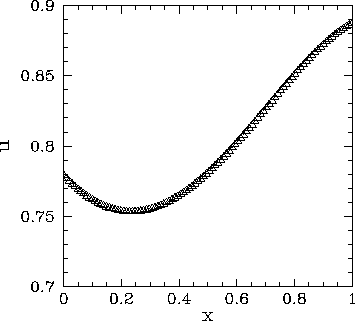


Next: 2-d problem with Dirichlet
Up: Poisson's equation
Previous: An example 1-d Poisson
Let us now solve Poisson's equation in one dimension, with mixed boundary conditions,
using the finite difference technique discussed above. We seek the
solution of
 |
(142) |
in the region  , with
, with
 . The boundary conditions
at
. The boundary conditions
at  and
and  take the mixed form specified in Eqs. (132) and
(133). Of course, we can solve this problem analytically. In fact,
take the mixed form specified in Eqs. (132) and
(133). Of course, we can solve this problem analytically. In fact,
 |
(143) |
where
Figure 62 shows a comparison between the analytic and finite difference
solutions for  . It can be seen that the finite difference solution mirrors
the analytic solution almost exactly.
. It can be seen that the finite difference solution mirrors
the analytic solution almost exactly.
Figure 62:
Solution of Poisson's equation in one dimension with  ,
,  ,
,  ,
,
 ,
,  ,
,  , and
, and  . The dotted curve (obscured)
shows the analytic solution, whereas the open triangles show the finite difference
solution for
. The dotted curve (obscured)
shows the analytic solution, whereas the open triangles show the finite difference
solution for  .
.
 |



Next: 2-d problem with Dirichlet
Up: Poisson's equation
Previous: An example 1-d Poisson
Richard Fitzpatrick
2006-03-29
![$\displaystyle \frac{\gamma_l\,(\alpha_h+\beta_h) - \beta_l\,[\gamma_h-(\alpha_h+\beta_h)/3]}
{\alpha_l\,\alpha_h + \alpha_l\,\beta_h-\beta_l\,\alpha_h},$](img724.png)
![$\displaystyle \frac{ \alpha_l\,[\gamma_h-(\alpha_h+\beta_h)/3]-\gamma_l\,\alpha_h}
{\alpha_l\,\alpha_h + \alpha_l\,\beta_h-\beta_l\,\alpha_h}.$](img726.png)
